Relay-intercropping soybean with maize maintains soil fertility and increases nitrogen recovery efficiency by reducing nitrogen input
Qing Du,Li Zhou, Ping Chn, Xiaoming Liu, Chun Song, Fng Yang,Xiaochun Wang, Wiguo Liu, Xin Sun, Junbo Du, Jiang Liu, Kai Shu,Wnyu Yang, Taiwn Yong,*
aCollege of Agronomy,Sichuan Agricultural University,Chengdu 611130,Sichuan,China
bCollege of Environment,Sichuan Agricultural University,Chengdu 611130,Sichuan,China
cSichuan Engineering Research Center for Crop Strip Intercropping System/Key Laboratory of Crop Ecophysiology and Farming System in Southwest,Ministry of Agriculture,Chengdu 611130,Sichuan,China
dYibing Academy of Agricultural Sciences,Yibing 644000,Sichuan,China
eShehong Farm Bureau, Suining 629200,Sichuan,China
Keywords:Maize-soybean relay intercropping Reduced nitrogen Biological nitrogen fixation Nitrogen recovery efficiency Soil nitrogen dependent rate
ABSTRACT Optimized nitrogen (N) management can increase N-use efficiency in intercropping systems. Legume-nonlegume intercropping systems can reduce N input by exploiting biological N fixation by legumes. Measurement of N utilization can help in dissecting the mechanisms underlying N uptake and utilization in legume-nonlegume intercropping systems. An experiment was performed with three planting patterns: monoculture maize(MM),monoculture soybean(SS),and maize-soybean relay intercropping(IMS),and three N application levels:zero N(NN),reduced N(RN),and conventional N(CN)to investigate crop N uptake and utilization characteristics.N recovery efficiency and15N recovery rate of crops were higher under RN than under CN,and those under RN were higher under intercropping than under the corresponding monocultures.Compared with MM,IMS showed a lower soil N-dependent rate(SNDR)in 2012.However,the SNDR of MM rapidly declined from 86.8%in 2012 to 49.4% in 2014, whereas that of IMS declined slowly from 75.4% in 2012 to 69.4% in 2014.The interspecific N competition rate(NCRms)was higher under RN than under CN,and increased yearly. Soybean nodule dry weight and nitrogenase activities were respectively 34.2% and 12.5% higher under intercropping than in monoculture at the beginning seed stage.The amount(Ndfa)and ratio(%Ndfa)of soybean N2 fixation were significantly greater under IS than under SS.In conclusion,N fertilizer was more efficiently used under RN than under CN; in particular, the relay intercropping system promoted N fertilizer utilization in comparison with the corresponding monocultures. An intercropping system helps to maintain soil fertility because interspecific N competition promotes biological N fixation by soybean by reducing N input. Thus, a maize-soybean relay intercropping system with reduced N application is sustainable and environmentally friendly.
1. Introduction
The global population is predicted to increase to 9-12 billion in 2100 [1], leading to severe food security problems. Crop yields must be improved to meet daily food consumption[2].Intercropping, as one of the multiple cropping systems, can result in higher crop yields and has long been practiced in many countries and territories, including China, India,Africa, West Asia, and Latin America [3]. Intercropping can be classified into two types: strip intercropping, in which crops are cultivated simultaneously in different strips, and relay intercropping, in which late-season crops are planted by row at a late stage of growth of early-season crops [4].Compared with sole cropping,intercropping can make better use of resources, including light, nutrients, water, and farmland,and increase land productivity[5,6].Intercropping can also control pests,diseases,and weeds[7].Intercropping is an effective approach to reducing N fertilizer input while stabilizing crop yields [8]. In particular, legume-cereal intercropping systems can increase N-use efficiency (NUE)and yield with reduced chemical N fertilizer input.Not only do legumes fix N fixation from the atmosphere by biological N fixation (BNF) [9], but chemical N fertilizer can be efficiently utilized via interspecific N competition [10]. For example,the inorganic N competitive ability of barley was 30 times higher than that of pea in an intercropping system[11]. A similar trend was observed in wheat/faba bean intercropping systems, where wheat had a much stronger competitive ability for soil N than faba bean[12].N leaching of maize was 15%-37% lower in maize-red fescue intercropping than in monoculture maize because of residual inorganic N in the soil profile[13].
Although N fertilizer plays a key role in increasing crop yield [14], excessive N input results in wasting of resources,reduction of NUE, and environmental pollution. Residual N fertilizer in the soil profile can be lost by leaching,runoff,and emissions [15]. N loss by leaching and runoff can result in eutrophication, and reactive N emissions can lead to air pollution and global warming[16-18].Agricultural production with a high environmental cost is contrary to the sustainable development of agriculture.
In recent years,diverse N management strategies aimed at increasing NUE and reducing environmental costs have been practiced[8,19-22].Reduced N application is developing as an N fertilizer management approach, with the aim of guaranteeing the stability of crop production while reducing N fertilizer input,thus enhancing NUE and reducing environmental pollution [21]. It has been well demonstrated [8,22,23]that appropriate N reduction does not result in large decreases of crop yield; on the contrary, it offers several benefits, including increasing NUE, reducing N losses, and maintaining soil fertility.
In a previous study [24], intercropping of oats with peas was effective in producing feed grain with reduced N input.A maize-soybean relay intercropping system with reduced N input maintain land productivity [25]. Reduced N input with an optimized method, namely strip-placed fertilizer at a distance of 15 cm from maize rows to soybean rows,increased total yield by 12.3% compared with conventional N application in maize-soybean relay intercropping [26].A total N application rate in sugarcane-soybean intercropping with an N reduction from 525 to 300 kg N ha-1maintained sugarcane yield while reducing N2O emission [21]. Thus,intercropping can result in high yields at reduced environmental cost.To realize its promise,efforts to improve N-cycle assessment and evaluation of N management strategies and practices are needed.
In our previous study[27],there was competition for crop N uptake in a wheat-maize-soybean relay intercropping system.However, it is unclear whether or not reduced N can improve N uptake and utilization,and the mechanisms of N utilization are still unclear in maize-soybean relay intercropping. We hypothesized that crops differing in N utilization will increase N recovery efficiency(NRE)and maintain the farmland N pool,and that soybean biological N fixation can be enhanced by N competition in a maize-soybean relay intercropping with reduced N input.The objective of this study was to investigate the characteristics of N uptake and utilization under maizesoybean relay intercropping with reduced N input using a three-year field experiment and a15N labeling micro-plot experiment to measure the effects of N fertilizer application rates and planting patterns on crop N uptake.15N recovery rate, NRE, total N content of the soil, soil N dependent rate,interspecific N competition,and soybean biological N fixation were also investigated.
2. Materials and methods
2.1. Experimental site
A field experiment was conducted at a fixed place during 2012-2014 at the Modern Food Industry Demonstration Base of Renshou in Sichuan province,southwestern China(29°40′-30°16′N, 104°00′-104°30′E). The soil characteristics in 2012 were as follows: pH 6.8, organic matter content 17.26 g kg-1,total N content 0.9 g kg-1, total P content 0.50 g kg-1, total K content 14.28 g kg-1,available N content 77.35 mg kg-1,Olsen-P content 22.83 mg kg-1, and available K content 196.63 mg kg-1.
Seeds of maize (Zea mays L. cv. Denghai 605) and soybean(Glycine max L. cv. Nandou 12) were provided by Shandong Denghai Pioneer Seed Industry Company Limited and Agricultural Science Institute of Soybean in Nanchong, Sichuan province, respectively.15N isotope fertilizer (NO3) was provided by Chemical Industry and Research Institute of Shanghai(15N abundance = 10.02 atom%).
2.2. Experimental designs and treatments
2.2.1. Field experiment
In 2012-2014, the field experiment was characterized by three planting patterns (main factor): monoculture maize (MM),monoculture soybean (SS), and maize-soybean relay intercropping(IMS),with three total N fertilizer application rates(secondary factor):zero N(NN),reduced N,by 25%compared with CN (180 kg N ha-1) (RN), and conventional N employed by local farmers(240 kg N ha-1)(CN).The two factors were arranged in a split-plot design.Maize-soybean relay intercropping employed a wide/narrow row planting pattern. In each relay intercropping system, two rows of maize spaced 0.4 m apart were alternated with two rows of soybean also spaced 0.4 m apart, with 0.6 m separating maize and soybean rows.This row configuration was optimized to balance the competitive relationships between aboveground and belowground of crops[28].The two row spacing of MM and SS were 1.0 m and 0.5 m,respectively(Fig.1).Each plot included 3 strips of intercropping,with the area of an individual strip being 2.0 m × 6.0 m.All treatments had three replicates,so that each plot area was 36 m2. The plant density was 58,500 plants ha-1for maize and 117,000 plants ha-1for soybean.Plant density and within-row plant spacing (0.17 m in all plots) were identical for the monoculture and relay intercropping systems.The post-emergence density of monoculture maize and soybean was the same as that of intercropped maize,which was one plant per hole, whereas that of the intercropped soybean postemergence was two plants per hole.
Fertilization of monoculture crops followed the method employed by local farmers, whereas that for relay intercropping followed our previously published reports[25,26]. Urea, superphosphate, and potassium chloride were used as N, P, and K fertilizers. All P and K fertilizers for crops were applied as basal fertilizer at 105 kg P2O5ha-1and 112.5 kg K2O ha-1for maize and 63 kg P2O5ha-1and 52.5 kg K2O ha-1for soybean.N fertilizer for soybean in all treatments was applied as basal fertilizer at 45 kg N ha-1, and that for maize was divided into two applications: 72 kg N ha-1for basal fertilizer and the remaining 63 kg N ha-1for topdressing(Table S1). The total N fertilizer for the IMS was the sum of N fertilizers for the corresponding monocultures. In the intercropping system, the N, P, and K fertilizers for soybean were applied when soybean was sown, mixed with the N topdressing application for maize and placed in a strip 25 cm from the maize rows. In the corresponding monocultures,fertilizers were mixed and strip-placed between the corresponding rows [26].
Maize was sown on April 1, 2012, April 3, 2013, and March 29, 2014 and harvested on July 29, 2012, August 1, 2013, and July 26,2014,respectively.Soybean was sown on June 10,2012,June 11, 2013, and June 9, 2014, and harvested on October 31,2012,October 29,2013,and October 28,2014,respectively(Fig.S1). In both field and micro-plot experiments, no crops were planted in the same field before sowing of soybean or after the maize harvest.
2.2.2.A micro-plot experiment
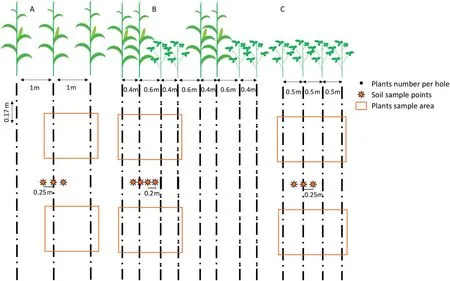
Fig.1- Plant patterns and sampling points for field experiment from 2012 to 2014.A. Monoculture maize;B. maize-soybean relay intercropping system;C.monoculture soybean.
In 2012, an independent15N labeling micro-plot experiment was nested in the second strip of each plot in the field experiment with the purpose of investigating the characteristics of N uptake and use by crops. The micro-plot received the RN and CN treatments of the three planting patterns (MM, SS, and IMS). Each treatment was applied with three replications,so that the total number of micro-plots was 18. Under the MM and SS treatments, a soil column with an area of 2.00 m × 0.38 m was excavated and under the IMS a column with area 2.00 m × 0.95 m.Both pits were surrounded by a bottomless sheet of zinc with the top of the sheet 0.1 m above the ground. Four plants were placed in the MM and eight in the SS,whereas the IMS micro-plots received 10 maize and 20 soybean plants.was used as N fertilizer in micro-plots after dissolution in distilled water (Table S1). P and K fertilization of the micro-plots was applied with the same levels and methods as in the field experiment. The sowing and harvest dates of maize and soybean were with the same as for the field experiment(Fig.S1).
2.3. Plant sampling, measurements, and calculation
2.3.1.Plant biomass,N uptake,N recovery efficiency(NRE),and N competition ratio(NCRms)
In the field experiment,eight maize and eight soybean plants from each monoculture plot and eight maize and 16 soybean plant samples from each intercrop plot were collected at each harvest stage. Plant samples were divided into stems, grain,and roots and oven-dried first at 105 °C for 30 min and then at 75 °C to constant weight. They were then ground and passed through a 60-mesh (0.250 mm) stainless steel sieve. N contents were determined with an automatic Kjeldahl instrument(Kjeldahl 8400,FOSS,Denmark).
Nitrogen recovery efficiency(NRE)[29]and nitrogen competition ratio(NCRms)[30-32]were calculated as follows:

where N,N0,and Naare the aboveground plant N uptake in the fertilized area, non-N fertilizer, and total N application rate,respectively; Nimand Nisrepresent the respective maize and soybean N concentrations in relay intercropping; and Nmmand Nssrepresent the monoculture maize and soybean N concentrations, respectively. An NCRms>1 indicates a stronger competitive ability for maize than for soybean, NCRms<1 indicated a weaker competitive ability for maize than for soybean.
2.3.2.Plant15N uptake(Ndff)and15N marked fertilizer recovery rate (%NRR)
In the micro-plot experiment, all plant samples (four maize and eight soybean plants) including roots were collected to determine plant N content and15N% abundance at each crop harvest stage. N content was determined by the micro-Kjeldahl method [33] and the resulting distillate was concentrated to 1 mL before determination of15N%abundance using a Delta V Isotope Ratio Mass Spectrometer (Thermo-Fisher delta V advantage IRMS,USA).
The percentage of15N from the plant (% Ndff) [14,34] was calculated using Eq.(3).Ndff(mg plant-1)was calculated using Eq.(4).%NRR was calculated using Eq.(5).


where δ15Npand δ15Nfare the atom%15N excesses of the plant and N fertilizer, respectively. Nitrogen atom percent excess(atom%15N excess) was equal to the difference between the15N% of the marked samples (15Nmarked) and unmarked samples(no N fertilizer treatment).
2.3.3.Soil total N content, soil N dependent rate
Soil samples were collected using a soil auger(0-20 cm depth)in each field treatment at each crop harvest stage.There were three sampling points in the monoculture crops, lying on a line perpendicular to maize or soybean rows at 0 and 25 cm from the rows. There were four sample points in the intercropped maize and soybean treatment, lying on a line perpendicular to the rows and 0 and 20 cm from the rows.The distances between wide rows were 20 cm and 40 cm (Fig. 1).The air-dried soil samples were mixed, crushed, and passed through a 60-mesh stainless steel sieve,). Soil samples were divided into two subsamples.One was used for determination of total N content by the Kjeldahl method [33] and the other was used for determination of soil15N abundance using the same method of plant15N abundance measurement described in the previous section.
Soil N dependent rate (SNDR) [35] was calculated as follows:

where N and N0are the aboveground plant N uptake in the fertilized area and the non-N fertilizer rate,respectively.
2.3.4. Soybean nodule dry weight, nitrogenase activity, and biological nitrogen fixation (BNF)
Soybean nodule samples in the field experiment were collected at V5(fifth trifoliate stage),R2(full bloom stage),and R5(Beginning seed stage)stages.Plant aboveground parts were separated from cotyledons and roots were collected by digging out a 38 cm(length) × 40 cm (width) × 30 cm (depth) volume. This soil was immediately placed in a nylon net bag and quickly rinsed in ice water to removed soil attached to the roots. Soybean nodules were collected and counted after the wash water was passed through a 60-mesh stainless steel sieve.Before fresh weight was determined, the nodules were dried on blotting paper, after which 2-g nodule samples were frozen in liquid nitrogen for later determination of nitrogenase activity. Nodule dry weight was determined after oven drying at 75 °C to a constant weight.
Soybean nodule nitrogenase activity was determined by the acetylene reduction method. All nodules of each sample were mixed and a 1-g subsample was placed into a 10 mL penicillin bottle, which was injected with 2 mL acetylene gas and then incubated for 30 min in a 30 °C constant temperature water bath.Finally a 0.1 mL gas sample was injected into an atmosphere chromatographic analyzer. The gas-phase conditions were as follows [36]: column temperature of 60 °C, injection port temperature of 120 °C, and flame ionization detector temperature of 120 °C. The gas flow velocities were as follows: N2, 50 mL min-1; H2, 60 mL min-1;air,50 mL min-1.
Soybean BNF was determined using the15N natural abundance method [37,38]. As a relatively stable isotope in the atmosphere,15N has an atomic abundance of 0.3663%,considered the15N standard isotope abundance [39]. The sample relative abundance is usually expressed as the δ15N,which was calculated using Eq.(7).

where atom%15Nmarkedand atom%15Natmosphereare the δ15N atom abundances of a marked sample and the standard δ15N atom abundance of the atmosphere(0.3663%),respectively.
The ratio of soybean biological N fixation (%Ndfa) was calculated using Eq. (8).

where δ15N(ref)and δ15N(BNF plant)are the δ15N abundances of non-N-fixing-plants and N-fixing plants, respectively.Sweet potato was used as the non-N-fixing plant and grown in the same soil to calibrate the N fixation ability of soybean.B represents the δ15N abundance of soybean (an N-fixing plant grown in N-free medium).
The amount of soybean N2fixation (Ndfa) was calculated using Eq.(9).

where Mlb and Cnc are the biomass of soybeans per unit area(kg ha-1), and the total N content of soybean (kg kg-1),respectively.
2.4. Statistical analysis
Data were processed using Microsoft Excel 2003 and figures were drawn with Sigma Plot V.12.5 and Origin Pro 8.Differences between means were identified by analysis of variance(ANOVA), with planting patterns and N treatments treated as fixed factors and replicates and years as random factors, and data as the dependent variable.Means were compared by least significant difference (LSD) multiple comparisons at P <0.05 using SPSS 20.0(SPSS,Chicago,IL,USA).
3. Results
3.1. Crop biomass, N uptake, and 15N uptake
There were no differences in biomass or aboveground N uptake of crops between the intercropping system and the corresponding monocultures (Table 1). Under the three N application rates, biomass and N uptake for monoculture maize was higher in CN than in RN, whereas these of intercropped maize were respectively 7.6% and 12.3% higher in RN than in CN, (Table 1). Biomass and N uptake of intercropped soybean were significantly greater, by 10.0%and 13.8%respectively,in RN than in CN(Table 1).
The effects of planting patterns and N input on crop15N uptake are shown in Fig. 2. Although the differences in maize stem and grain15N uptake between intercropping and monoculture were not significant, the15N uptake of maize roots under intercropping was significantly decreased in comparison with the monoculture (Fig.2). Compared with CN,the15N uptakes of maize stem, grain, and total accumulation was increased by respectively 12.2%, 17.3%, and 14.4% in RN,and that of maize root was decreased by 11.2%in RN(Fig.2).The15N uptakes of soybean root,stem,and total accumulation were highly significantly greater in intercropped soybean than in monoculture soybean. In relay intercropping, soybean root,stem, grain, and total accumulation15N uptakes were significantly decreased in RN compared with CN.
3.2. Soil total N content and 15N% abundance
Soil total N content of maize was increased by 12.4% in relay intercropping compared with monoculture, and the15N%abundance of maize was decreased by 2.0% in intercropping compared with monoculture(Table 2).In comparison with NN,the soil total N content and15N% abundance of maize were significantly increased in RN and in CN, respectively. The soil total N content of intercropped maize was higher in RN than in CN, whereas the15N% abundance of intercropped maize was greater in CN than in RN(Table 2).For soybean,the soil total N content and15N%abundance were decreased by 8.4%and 3.0%in intercropping compared with monoculture(Table 3),respectively.In short,the soil N content15N%abundance of soybean in relay intercropping was highest under the RN treatment compared to the other treatments(Table 3).
3.3. NRE, 15N recovery rate (%), and SNDR
The NRE of maize was not significantly affected by planting pattern (Table 4). However, the NRE of soybean was significantly increased by 84.3% in relay intercropping compared to monoculture (three-year means). Compared with CN, the NREs of maize and soybean in RN were increased by respectively 140.8% and 129.5% for relay intercropping and 32.1%and 565.6%for monoculture.Similarly,although the15N recovery rate of maize was not significantly affected by planting pattern, that of soybean was significantly increased by 241.4% in intercropping compared with monoculture(Table 4). The maize15N recovery rates in monoculture and intercropping were increased by respectively 59.8%and 52.5%in RN compared with CN. For the15N recovery rate of monoculture soybean, there was no difference between RN and CN, whereas that of intercropped soybean was significantly decreased by 42.8%in RN relative to CN(Table 4).
The soybean SNDR was significantly increased by 22.4%in SS compared with IMS (Table 5). Although the SNDR of MM showed no difference between RN and CN, those of SS and IMS in RN were significantly decreased,by respectively 18.3%and 12.3%,compared with CN.The annual change of SNDR in IMS and MM showed a decreasing trend and that of SNDR in SS showed an increasing trend.
In 2012, the NCRmswas lower than 1 and decreased with the increase in N application rates (Fig. 3). Application of N fertilizer alleviated interspecific N competition. However, the NCRmswas increased from 2012 to 2014,and the NCRmsof CN was lower than that of RN. Stronger interspecific N competition was a benefit of increasing the BNF of soybean in IMS(Table 6). It forced soybean under relay intercropping to fix N from the atmosphere, thereby alleviating the interspecific N competition between maize and soybean.
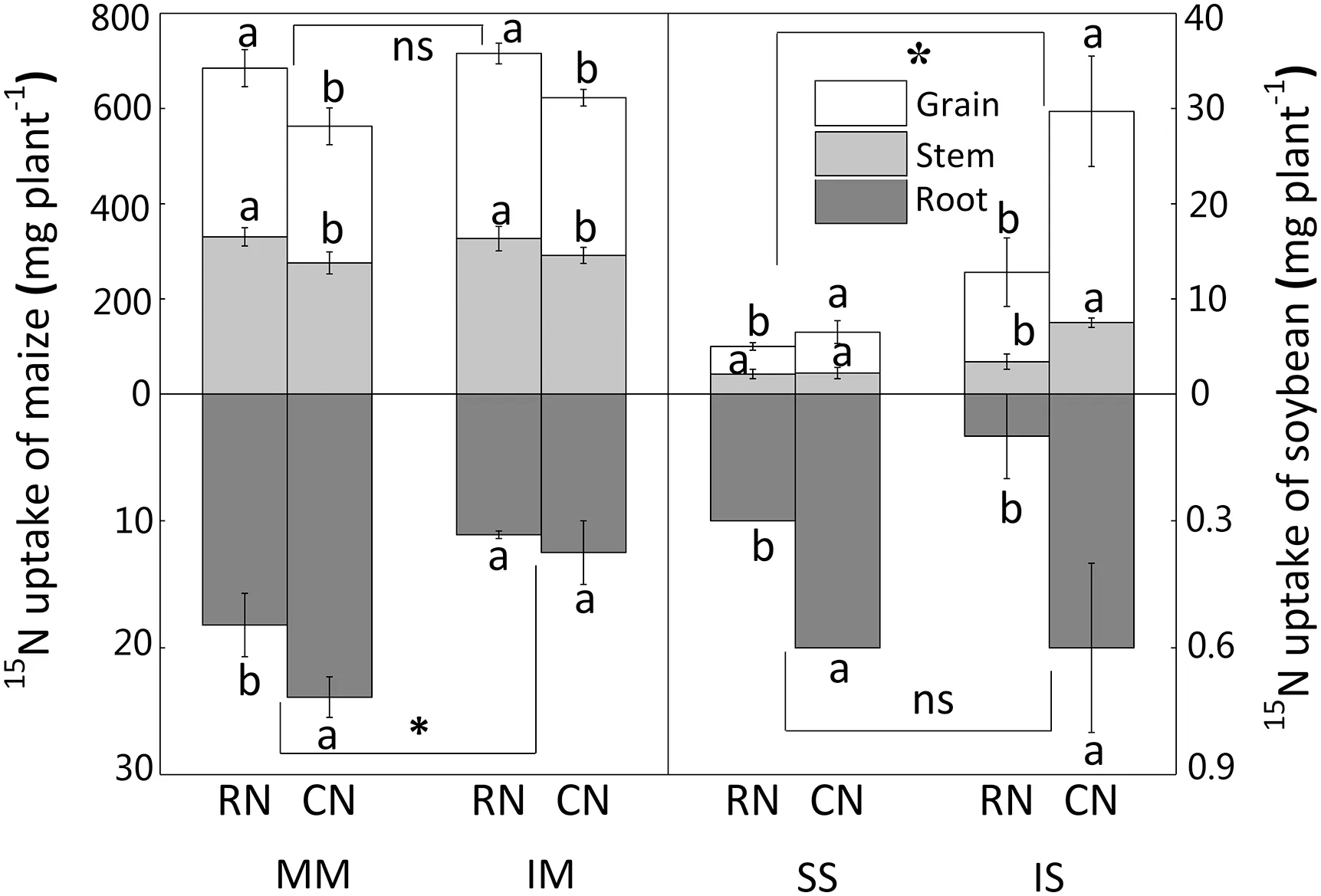
Fig.2- Effects of N application rate and planting pattern on maize and soybean 15N uptake(mg plant-1)at the harvest stage(2012).Different lowercase letters within each cluster indicate significant differences under three N treatments(LSD,P <0.05).The asterisk(*)and (**),and (ns)indicate significant difference(P <0.05),highly significant difference(P <0.01),and no significant difference(P >0.05)under different planting patterns.MM,monoculture maize;IM, intercropped maize;SS,monoculture soybean;IS,intercropped soybean;RN, reduced N;CN,conventional N.
3.4. Soybean biological nitrogen fixation
With soybean growth, nodule dry weight was increased(Table 6). Nodule dry weight was highest at the R2 stage in monoculture and at the R5 stage under intercropping. Under different levels of N input,the nodule dry weight of IS and SS in RN was higher than that of CN during the three sampling stages,except that the nodule dry weight of SS was highest in NN at the R2 stage (Table 6). Compared with SS, the nitrogenase activity of soybean in IS was increased by 132.7% at the R2 stage, and by 12.5% at the R5 stage.Application of N fertilizer resulted in a decrease in soybean nitrogenase activity (Table 6). However, the nitrogenase activity of soybean was higher in RN than in CN. Under different planting patterns, N uptake was significantly decreased,by 11.6%,in IS compared with SS,whereas the%Ndfaand Ndfa of IS were significantly increased, by respectively 23.8%and 9.4%,compared with SS(Fig.4).
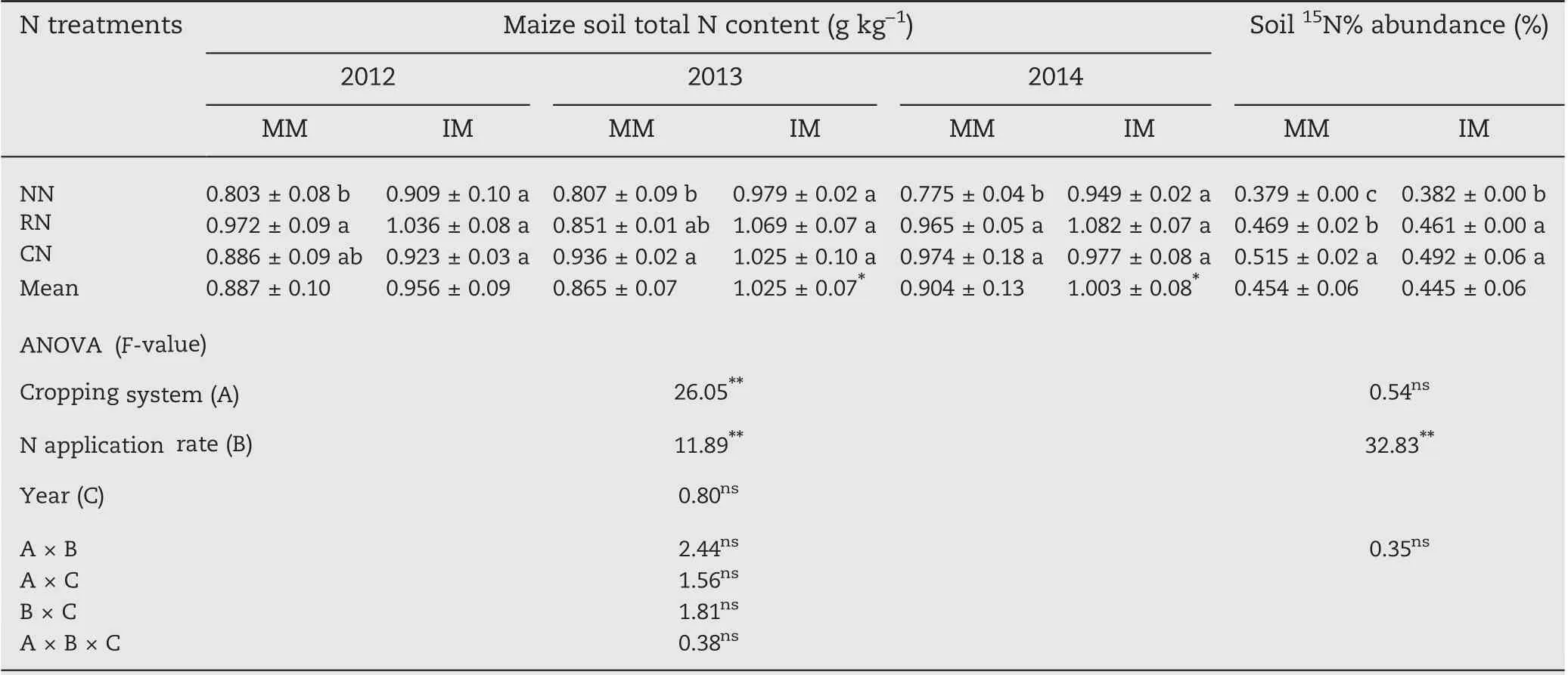
Table 2-Maize soil total N content(g kg-1)and 15N abundance(%)under different N application rates and planting patterns at the harvest stage. Values for soil total N content are means of three years (2012-2014) and those for 15N abundance are means for 2012.

Table 3-Soybean soil total N content (g kg-1) and 15N abundance (%) under different N application rates and planting patterns at the harvest stage. Values for soil total N content are means of three years (2012-2014) and those for 15N abundance are means for 2012.
4. Discussion
4.1.Characteristics of crop nitrogen uptake and use in maizesoybean relay strip intercropping systems
Intercropping can increase crop productivity by promoting efficient use of resources[5-7].Legumes can increase N input through BNF,which reduces the need for chemical N fertilizer.For example, the annual potential N fixation ability of soybean is 118 kg N ha-1, that of alfalfa is 218 kg N ha-1, and that of hay is 79 kg N ha-1[40]. Interspecific N competition can increase N uptake by non-legumes and strengthen the BNF ability of legumes in an intercropping system[27].
A well-developed fine root system instead of great root biomass can promote N uptake by maize [41]. In the present study,biomass and aboveground N uptake by maize in the field were no different under intercropping than under monoculture(Table 1).However,in the micro-plot experiment,15N uptake by maize roots was significantly lower under intercropping than under monoculture, while that of maize grain was greater(Fig.2).This finding may be explained by a greater development of the fine root system of maize under intercropping than under monoculture. Thus, intercropped maize can efficiently absorband, thereby promoting aboveground growth.Besides,the results of this study showed that the NRE and15N recovery rate of maize were higher in the intercropping than those in the monoculture,which is consistent with the previous study that the15N recovery rate of wheat can be increased through below-ground interactions in a wheat/faba bean intercropping[12].
Meanwhile, the rapid decrease of SNDR indicates a decrease in soil fertility [35]. In the present study, the SNDR was rapidly decreased in MM compared with IMS,whereas the SNDR of SS was greater than that of IMS (Table 5). These findings suggest that the soil N consumed by maize was compensated to some degree by BNF of soybean in IMS compared in MM. This finding is consistent with previous findings [12,27,42] that cereals occupy the dominant niche and have the advantages of N competitive absorption compared with that of legumes in intercropping systems.
Soybeans were sown at the silking stage of maize,and the coexistence period spanned approximately 50 days before maize harvest(Fig.S1).In previous studies[43-45],shading of soybean seedlings by maize in relay intercropping systems impaired their growth. However, after the maize harvest, the compensatory growth of soybean contributes to increasing the biomass, thereby increasing N uptake of soybean in maize-soybean relay intercropping systems [25,45,46]. In the present study, the aboveground biomass and N uptake of soybean did not differ under intercropping in comparison with monoculture at the mature stage. The finding that15N uptake, NRE, and15N recovery rate of soybean were significantly higher under intercropping than under monoculture indicates that recovery growth of soybean contributed to N accumulation under relay intercropping.
It is well-known that legumes can fix N2from the atmosphere[40].In this study,the nitrogenase activity was greater in IS than in SS at the R2 and R5 stages(Table 6).Ndfa and%Ndfa were significantly greater in IS than in SS(Fig.4),in agreement with a previous [47] finding that root exudates of maizepromoted legume nodule formation and increased BNF by legumes. Similarly, %Ndfa and Ndfa increased in intercropped faba bean compared with monoculture faba bean [10]. In the present study, the soil total N content of maize was markedly higher under intercropping than under monoculture, whereas that of soybean was greater under monoculture than under intercropping (Tables 2, 3). These results indicate that the N demand of maize growth can be met by strengthening the BNF of soybean when N is insufficient,in agreement with a previous[12]finding that intercropping resulted in an increase of soil N content in wheat and a decrease in faba bean. The soil15N%abundance of maize was higher under monoculture than under intercropping,and the soil total N content of maize was greater under intercropping than under monoculture in the first cropping season(Table 2).This finding probably resulted from the efficient utilization of N fertilizer instead of soil N in intercropping during the first cropping season. In NN, the soil total N content was decreased in MM compared with that in IM,because the N demand for maize growth can be met in some degree by the BNF of soybean[27].The soil total N content of RN and CN were increased compared with that of NN, owing to residual chemical N. In the subsequent cropping seasons, the soil N content of RN and CN tended to be stable,while that of NN showed a continuous decrease.Those conditions finally led to a decrease of SNDR and an increase of NRE in both RN and CN.A lower N loss proportion can be achieved under intercropping than under the corresponding monocultures, reducing N fertilizer loss and increasing NUE[48].

Table 4-N recovery efficiency (%) and 15N recovery rate (%) of maize and soybean under different N application rates and planting patterns at the harvest stage.Values for NRE are means of three years(2012-2014)and those for 15N recovery rate are means for 2012.
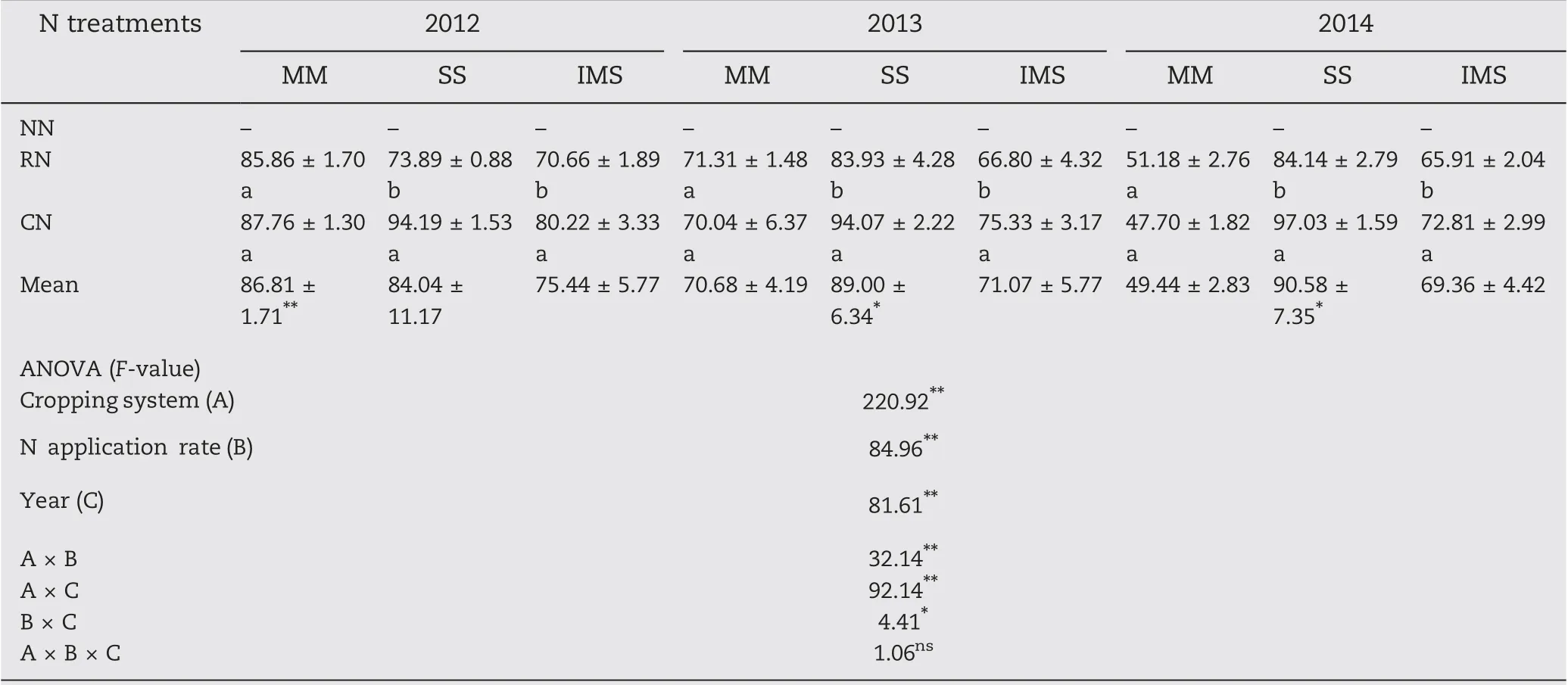
Table 5-The soil N dependent rate(SNDR,%)of maize and soybean under different N application rates and plant patterns.Values for SNDR are means of three years(2012-2014).
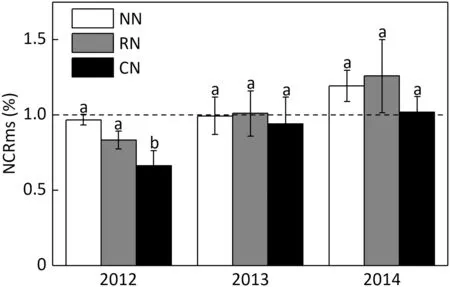
Fig.3- Nitrogen competition ratio(NCRms)in maize-soybean relay intercropping under different N fertilizer applications.Different lowercase letters within each cluster indicate significant differences under different N treatments for each cropping season(LSD,P <0.05).NN,zero N;RN, reduced N;CN,conventional N.Values are means of three replications.
Strong competitive use of soil N led to declining soil fertility in the wheat/faba bean system [10]. In the presentstudy, the NCRmsincreased with years (Fig. 3). Although the soil N was consumed by maize in the relay intercropping,the soil N pool was maintained by the BNF of soybean(Tables 2,3).This finding is consistent with that of the previous study [10]that the interspecific N competition rate of maize was weak relative to that of the legume. This disparity is probably accounted for by temporal and spatial differentiation of root niches [25], and the competitive use of soil nutrients can be alleviated by shaping root morphologies and distribution[10,49]. In summary, the results suggest that N fertilizer can be efficiently used by crops under relay intercropping in comparison with monoculture. Although maize consumed soil N to meet the demand for growth, the BNF of soybean helped to avoid the exhaustion of the soil N pool.The reduced soil N concentration that resulted from maize uptake can improve the BNF ability of soybean. The root exudates of maize also probably strengthened the BNF ability of soybean.However, the physiological and biochemical mechanisms of soybean BNF under relay intercropping await further study.

Table 6-Effects of N application rate and planting pattern on soybean nodule weight (g plant-1) and nitrogenase activity(C2H2 mL h-1 g-1)at the V5,R2 and R5 stages in the field experiment(2013).
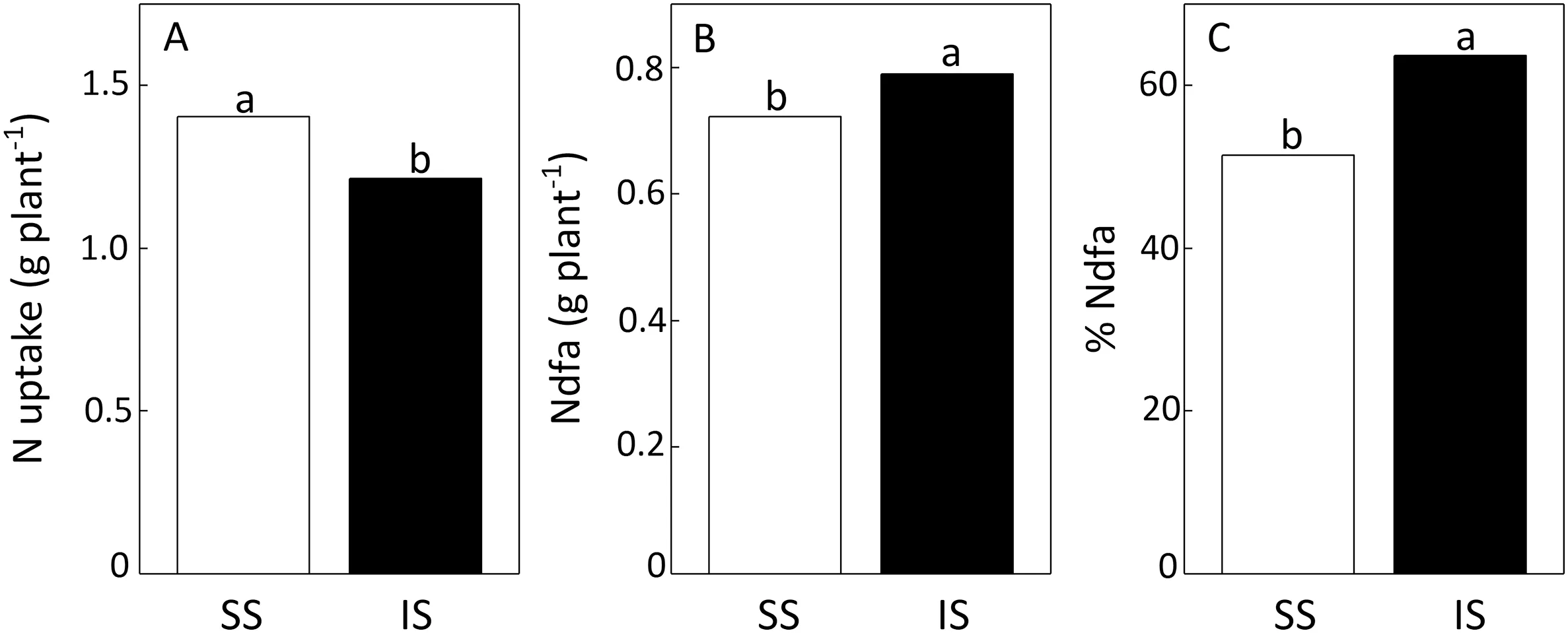
Fig.4-Effects of different planting patterns on soybean biological nitrogen fixation in 2013.A.Soybean N uptake;B.The total of soybean N2 fixed(Ndfa); C.The proportion of soybean biological N2 fixation(%Ndfa).Different lowercase letters indicate significant differences under different planting patterns(LSD,P <0.05).SS,monoculture soybean;IS,intercropped soybean.
4.2. Effects of N saving management on N use in the maizesoybean relay intercropping systems
Although N fertilizer plays a vital role in agricultural production, overuse of chemical N fertilizer reduces NUE and increases environmental cost [50]. Management strategies aimed at increasing productivity with low environmental cost are urgently needed.In previous studies[21,25,51],reduced N input reduced N leaching and N emissions and maintain grain yields and aboveground in legume/nonlegume intercropping systems, suggesting that legume/nonlegume intercropping provides an approach to sustainable agriculture. In the present study, the results showed that the N uptake of monoculture maize was highest in CN, while that of intercropped maize, monoculture soybean, and intercropped soybean was highest in RN (Table 1). Compared with CN, the aboveground15N uptake of maize was higher in RN, while those of maize root and soybean organs were lower in RN(Fig.2).This difference was observed probably because N loss and N mineralization differed under relay intercropping from those under the corresponding monocultures[48].
The soil total N contents of maize and soybean under intercropping were greater in RN than in CN. Compared with CN, the15N abundance of intercropped maize was lower in RN,but that of intercropped soybean was higher in RN(Tables 2, 3). These results suggest that more soil mineral N and less15N were consumed by monoculture maize in CN than in RN.In contrast,intercropped maize uptake more15N and less soil mineral N in RN than in CN.Finally,the NRE and15N recovery rate of maize and soybean were higher in RN than in CN(Table 4). These observations suggest that with mineral N exhausted, it is harder to meet the N demand for maize growth under monoculture than under intercropping. Although the NCRmswas lower than 1 in 2012, it increased from 2012 to 2014 (Fig. 3). In previous studies [43,51] a the relative nutrient competitive ratio of maize was stronger than that of soybean under maize-soybean strip intercropping,while the N demand for legume growth could be met by BNF when mineral N was insufficient.The explanation[25,45]was that relay intercropping has a shorter coexistence period than strip intercropping, so that recovery growth in relay intercropping can compensate at the later growth stages. In the present study,the NCRmsof CN was lower than that of RN.These results suggest that the application of N fertilizer alleviated interspecific N competition and that the interspecific N competition of maize was stronger in RN than in CN.
Legume/nonlegume intercropping can use N efficiently because the component crops can use soil mineral N, and legumes can fix N2thereby alleviating interspecific competition [11]. Irrespective of planting pattern, the %Ndfa of soybean changed from 51.4% to 63.6%. The %Ndfa and Ndfa of soybean were higher under intercropping than under monoculture (Fig. 4). This finding is consistent with that of a previous study [10] that %Ndfa was affected mainly by belowground interactions in a cereal/legume intercropping system. Soybean can reduce its N input requirements by BNF, satisfying 50%-60% of its N requirement for growth[52]. The difference in SNDR between CN and RN was not significant in monoculture maize, whereas the SNDRs of monoculture soybean and the intercropping system were greater in CN than in RN (Table 5). Because a high concentration of soil mineral N reduces soybean nodule N fixation, appropriate N fertilizer input is necessary [11,14].In the present study, the CN treatment reduced the BNF ability of soybean,and the N needed for growth was met by soil N uptake. In contrast, the RN treatment promoted BNF by soybean, and N needed for growth was met by strengthening BNF. As a result, the BNF of soybean was lower in CN than in RN.
In summary,these results suggest that the crop consumed mineral N, although soybean received increased N by fixing N2. Consequently, the soil total N content of IM in RN was highest, while15N abundance was lower in IM than in CN.Thus, relay intercropping with RN saved soil mineral N by increasing NRE and15N recovery rate,maintaining soil fertility via soybean BNF.
5. Conclusions
The soil total N content of MM was lower than that of IM,whereas SNDR rapidly decreased with years in MM compared with IM.Thus, the N demand for crop growth could be met by promoting soybean BNF in the maize-soybean relay intercropping, thereby achieving the goal of increasing NRE.Under reduced N application, the15N recovery rate was increased by 52.5% for intercropped maize in RN compared with CN.The soybean%Ndfa and Ndfa were respectively 23.8%and 9.4%higher under intercropping than under monoculture.IM showed reduced soil mineral N consumption and increased N fertilizer absorption in comparison with MM,and IMS showed increased N input by promoting BNF by soybean. Finally, the change trends of NCRmssuggested that N fertilizer input is needed to sustain long-term relay intercropping.In conclusion,the maize-soybean relay intercropping system with reduced N input assay is sustainable and efficient.
Supplementary data for this article can be found online at https://doi.org/10.1016/j.cj.2019.06.010.
Declaration of competing interest
The authors declare that they have no competing interests.
Acknowledgments
The research was supported by the National Natural Science Foundation of China (31671625, 31271669), and the National Key Research and Development Program of China(2016YFD0300202).
- The Crop Journal的其它文章
- Brief Guide for Authors
- Rapid generation advance(RGA)in chickpea to produce up to seven generations per year and enable speed breeding
- Transcriptomic responses in resistant and susceptible maize infected with Fusarium graminearum
- Genetic analysis and QTL mapping of stalk cell wall components and digestibility in maize recombinant inbred lines from B73 × By804
- Genetic bases of source-, sink-, and yield-related traits revealed by genome-wide association study in Xian rice
- Performance and yield stability of maize hybrids in stress-prone environments in eastern Africa

